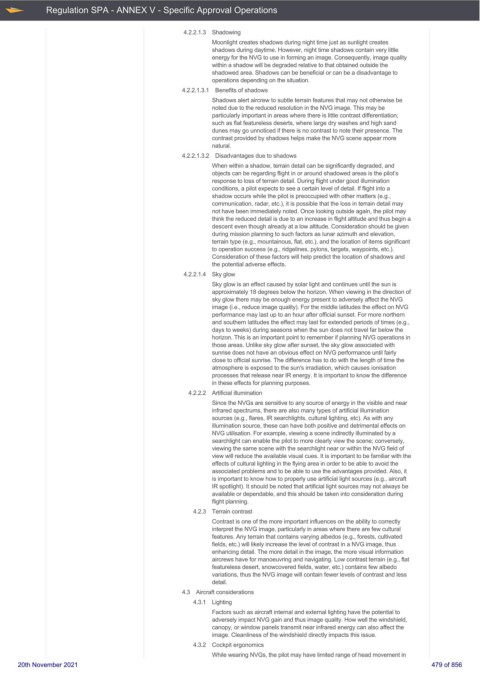Page 479 - UK Air Operations Regulations 201121
P. 479
~
~ Regulation SPA - ANNEX V - Specific Approval Operations Centrik
4.2.2.1.3 Shadowing
Moonlight creates shadows during night time just as sunlight creates
shadows during daytime. However, night time shadows contain very little
energy for the NVG to use in forming an image. Consequently, image quality
within a shadow will be degraded relative to that obtained outside the
shadowed area. Shadows can be beneficial or can be a disadvantage to
operations depending on the situation.
4.2.2.1.3.1 Benefits of shadows
Shadows alert aircrew to subtle terrain features that may not otherwise be
noted due to the reduced resolution in the NVG image. This may be
particularly important in areas where there is little contrast differentiation;
such as flat featureless deserts, where large dry washes and high sand
dunes may go unnoticed if there is no contrast to note their presence. The
contrast provided by shadows helps make the NVG scene appear more
natural.
4.2.2.1.3.2 Disadvantages due to shadows
When within a shadow, terrain detail can be significantly degraded, and
objects can be regarding flight in or around shadowed areas is the pilot’s
response to loss of terrain detail. During flight under good illumination
conditions, a pilot expects to see a certain level of detail. If flight into a
shadow occurs while the pilot is preoccupied with other matters (e.g.,
communication, radar, etc.), it is possible that the loss in terrain detail may
not have been immediately noted. Once looking outside again, the pilot may
think the reduced detail is due to an increase in flight altitude and thus begin a
descent even though already at a low altitude. Consideration should be given
during mission planning to such factors as lunar azimuth and elevation,
terrain type (e.g., mountainous, flat, etc.), and the location of items significant
to operation success (e.g., ridgelines, pylons, targets, waypoints, etc.).
Consideration of these factors will help predict the location of shadows and
the potential adverse effects.
4.2.2.1.4 Sky glow
Sky glow is an effect caused by solar light and continues until the sun is
approximately 18 degrees below the horizon. When viewing in the direction of
sky glow there may be enough energy present to adversely affect the NVG
image (i.e., reduce image quality). For the middle latitudes the effect on NVG
performance may last up to an hour after official sunset. For more northern
and southern latitudes the effect may last for extended periods of times (e.g.,
days to weeks) during seasons when the sun does not travel far below the
horizon. This is an important point to remember if planning NVG operations in
those areas. Unlike sky glow after sunset, the sky glow associated with
sunrise does not have an obvious effect on NVG performance until fairly
close to official sunrise. The difference has to do with the length of time the
atmosphere is exposed to the sun's irradiation, which causes ionisation
processes that release near IR energy. It is important to know the difference
in these effects for planning purposes.
4.2.2.2 Artificial illumination
Since the NVGs are sensitive to any source of energy in the visible and near
infrared spectrums, there are also many types of artificial illumination
sources (e.g., flares, IR searchlights, cultural lighting, etc). As with any
illumination source, these can have both positive and detrimental effects on
NVG utilisation. For example, viewing a scene indirectly illuminated by a
searchlight can enable the pilot to more clearly view the scene; conversely,
viewing the same scene with the searchlight near or within the NVG field of
view will reduce the available visual cues. It is important to be familiar with the
effects of cultural lighting in the flying area in order to be able to avoid the
associated problems and to be able to use the advantages provided. Also, it
is important to know how to properly use artificial light sources (e.g., aircraft
IR spotlight). It should be noted that artificial light sources may not always be
available or dependable, and this should be taken into consideration during
flight planning.
4.2.3 Terrain contrast
Contrast is one of the more important influences on the ability to correctly
interpret the NVG image, particularly in areas where there are few cultural
features. Any terrain that contains varying albedos (e.g., forests, cultivated
fields, etc.) will likely increase the level of contrast in a NVG image, thus
enhancing detail. The more detail in the image, the more visual information
aircrews have for manoeuvring and navigating. Low contrast terrain (e.g., flat
featureless desert, snowcovered fields, water, etc.) contains few albedo
variations, thus the NVG image will contain fewer levels of contrast and less
detail.
4.3 Aircraft considerations
4.3.1 Lighting
Factors such as aircraft internal and external lighting have the potential to
adversely impact NVG gain and thus image quality. How well the windshield,
canopy, or window panels transmit near infrared energy can also affect the
image. Cleanliness of the windshield directly impacts this issue.
4.3.2 Cockpit ergonomics
While wearing NVGs, the pilot may have limited range of head movement in
20th November 2021 479 of 856

